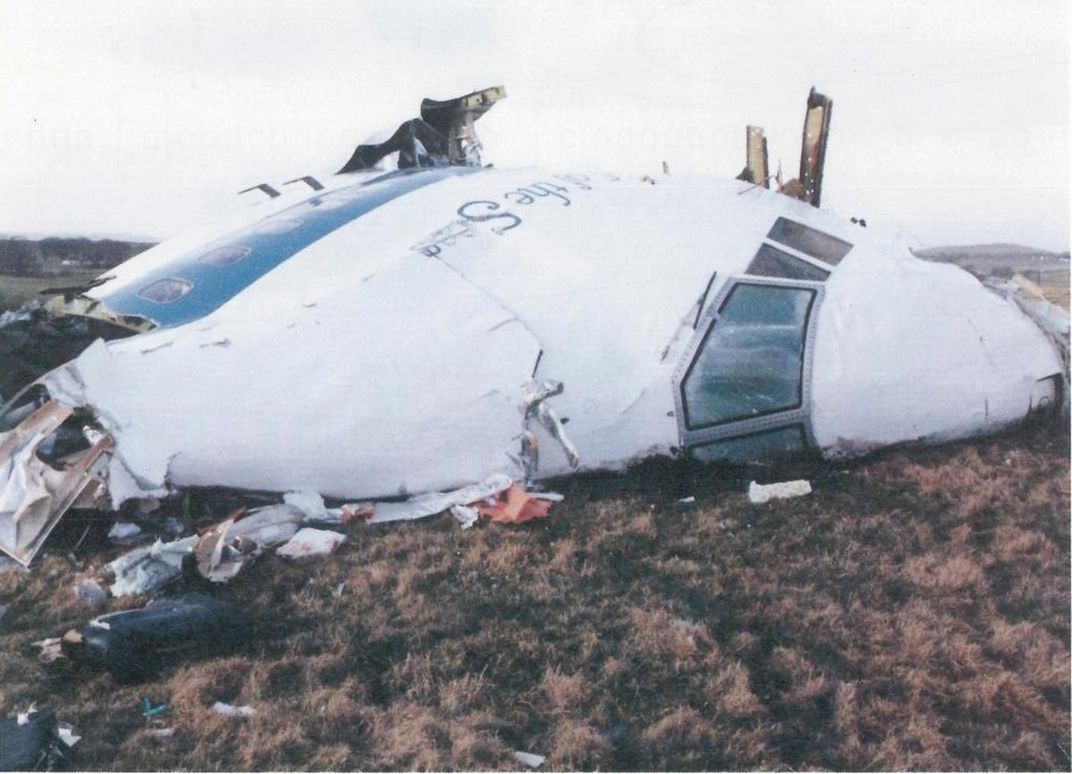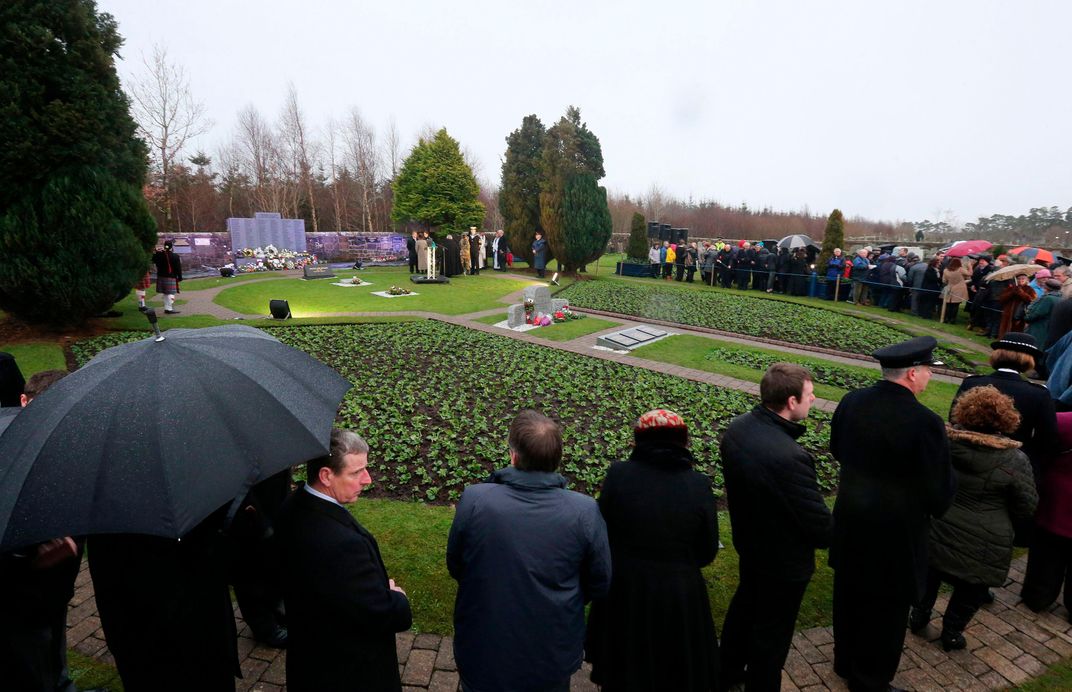A News Reporter at Lockerbie
In 1988, I went to the scene of one of the worst air disasters in history.
/https://tf-cmsv2-smithsonianmag-media.s3.amazonaws.com/filer/f7/d1/f7d16615-78f5-480a-8b44-edc6111d6761/17d_dj2017_gcjprk_live.jpg)
People who lived in Lockerbie, Scotland, said the sound was like a roll of thunder that swelled into a deafening roar. Then a flame-trailing chunk of wreckage from what two minutes earlier had been a Boeing 747-121 smashed into the ground like a meteorite.
Seconds later, the wings, containing almost 200,000 pounds of fuel, crashed vertically into Sherwood Crescent, a row of bungalows, and ignited upon impact. Some residents’ bodies were never found, obliterated by the conflagration. The time was shortly after 7 p.m. GMT, December 21, 1988.
When Pan Am 103 exploded, I was a reporter in the Glasgow office of The Scotsman. Founded in 1817, it was regarded as Scotland’s national newspaper.
I should not have been on duty that night. A colleague wanted to attend a concert, and had asked if he could swap the late shift with me. So shortly after 7 p.m. I was writing about an impending strike in a Clyde shipyard when the Glasgow editor—a 40-year veteran of the news business named Iain Duff—appeared beside my desk.
“We’re getting reports of an explosion in Lockerbie,” he said. “There’s a suggestion an aircraft may have crashed. Can you check it out? Maybe just get in the car and get down there.”
Lockerbie lay some 70 miles south of Glasgow, down a road that was one long accident blackspot. The thought of driving down there in our tiny pool car, in pitch dark and half a gale, did not appeal. My first thought was to call the “crash cell,” a small Royal Air Force contingent based at Prestwick Airport, about 35 miles southwest of Glasgow. Staff there were invariably helpful in providing information about any aviation incident. As usual, someone answered on the first ring.
“Duty officer, please.”
“He’s a bit tied up at the moment, sir. Can you call back later?”
They’d never been too busy to talk to me before. Duff was back at my desk, looking anxious. “Alan, I think you should just go,” he said.
I headed for the pool car. My growing suspicion was that two RAF aircraft had collided over the town. Lockerbie was in a zone for ultra-low military flight training, in which fast jets were allowed to operate at altitudes down to 100 feet. At low altitude and high speed, a tiny miscalculation could spell disaster. And two aircraft colliding could account for the garbled reports of multiple fires in the town now coming into the newsroom.

Driving out of Glasgow, I tuned the car radio to the BBC news. I was getting onto the southbound motorway when a program ended and the announcer broke in: “And now, before our next program, we’re going across to the BBC newsroom.” I swore to myself. Obviously this was serious.
“A Boeing 747 of Pan Am…” was all I heard before I swore again, rather less quietly this time, and floored the accelerator.
Two hours later, after evading police roadblocks and breaking several traffic laws, I pulled to a halt in Lockerbie. What I saw recalled photos from the London Blitz of 1940. The main road was covered in slate that had been blown off the roofs of buildings. Fire hoses snaked down the center of the street. There were strangely few people around. Military helicopters had been scrambled for what quickly became clear was a forlorn search for survivors. The sky was so crowded with Sea Kings that another crash seemed frighteningly plausible.
Almost exactly one hour before the explosion, the aircraft had pushed back at London Heathrow, bound for John F. Kennedy Airport in New York City. Pan Am Flight 103 carried 16 crew and 243 passengers, including 35 students from Syracuse University returning home after a semester abroad.
The 747 had climbed northwest over the United Kingdom, reaching a cruising altitude of 31,000 feet at 6:56 p.m. Seven minutes later, an air traffic controller at Shanwick Oceanic Control transmitted PA103’s oceanic clearance. There was no acknowledgment. At the same moment, the radar blip denoting the aircraft split into multiple returns. Pan Am 103, Clipper Maid of the Seas, had disintegrated.
An explosive device containing an estimated 12 ounces of Semtex hidden inside a Toshiba radio–cassette player had detonated in the forward cargo hold. The report released by the Air Accident Investigation Branch of the British government calculated that the explosion took less then three seconds to separate the forward fuselage from the rest of the airplane. Debris trails stretched almost 70 miles.
About two hours after I arrived in Lockerbie, Duff and photographer Donald MacLeod joined me. They were among the first to discover the 747’s cockpit section, which had come to rest close to a tiny church outside the town. The cockpit, lying on its side, became the iconic image of the tragedy.
Only in the light of day did the full scale of the devastation become apparent. One end of Sherwood Crescent was scarred by a huge, smoldering, wing-shaped pit. The houses that had not simply disappeared were gutted by fire, their roofs missing. Elsewhere, a 60-foot section of fuselage lay atop the flattened remains of houses. Remarkably, only 11 people on the ground had been killed.
I spent the next two days reporting on the grim recovery. Everyone in the aircraft had died. Bodies had fallen on the town, mainly on farmland and the golf course. Christmas Day at the town’s Dryfesdale Parish Church brought a hushed, intensely moving religious service. In the sky over the town, an RAF Canberra reconnaissance aircraft carrying infrared line scan equipment could be seen slowly wheeling, searching for wreckage.

Meanwhile, the townspeople opened their doors to the next of kin who had already begun to arrive from the United States and elsewhere. Those bereaved family members provided my most lasting memory of PA103—more than a year later, at the consecration of a memorial in Dryfesdale Cemetery, outside the town. It was a foul January day, gray cloud merging seamlessly with fog and drizzle. The visitors had spent the day thanking the locals for their succor, and by the time they reached the memorial in mid-afternoon the ceremony was behind schedule.
In Scotland at that time of year, dusk begins shortly after 3 p.m. The light was fading as the relatives placed flowers or quietly touched the newly carved names on the gray granite triptych. One man who had lost his daughter walked away from the group, head down, hands thrust into pockets, ignoring the rain and looking neither left nor right as he walked toward the cemetery gate. My mental image of Lockerbie is of that man slowly being swallowed by the gloom and swirling mist.
